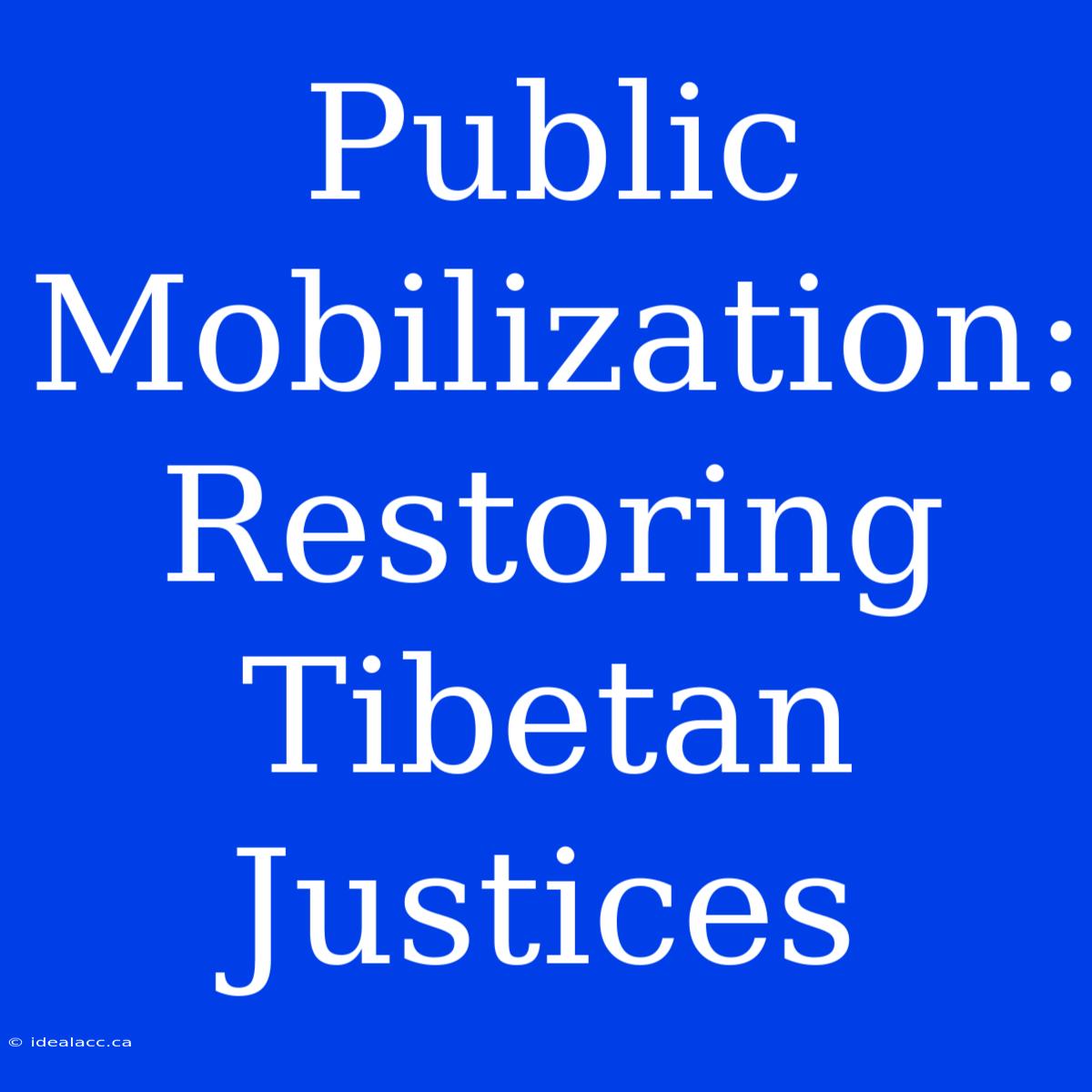Public Mobilization: Restoring Tibetan Justices
Is public mobilization the key to restoring Tibetan justice? Public mobilization has played a pivotal role in highlighting the plight of Tibetans and advocating for their rights. Editor Note: This article explores the power of public mobilization in the struggle for Tibetan justice.
Understanding this complex issue is crucial for anyone seeking to learn about the history, culture, and ongoing struggle for self-determination in Tibet. We delve into the motivations behind public mobilization efforts, examining their effectiveness and the challenges they face.
Analysis: We meticulously analyzed historical events, international reports, and the voices of Tibetan activists to understand the dynamics of public mobilization and its impact on the restoration of Tibetan justice. We researched the key strategies used by activists and the broader global movement for Tibetan rights.
Key Aspects of Public Mobilization for Tibetan Justice:
| Aspect | Description |
|---|---|
| Raising Awareness | Educating the global community about Tibet's history, culture, and human rights issues. |
| Advocacy and Lobbying | Pressuring governments and international organizations to support Tibetan autonomy and human rights. |
| Non-violent Resistance | Utilizing peaceful protests and demonstrations to raise awareness and challenge oppressive policies. |
| International Cooperation | Building coalitions with other human rights groups and organizations to amplify the Tibetan cause. |
| Cultural Preservation | Promoting Tibetan language, culture, and religious traditions as a form of resistance. |
Public Mobilization: A Vital Force for Tibetan Justice
Public mobilization has been essential in bringing international attention to the Tibetan struggle. By raising awareness, advocating for justice, and engaging in non-violent resistance, activists have kept the issue of Tibet on the global agenda.
Raising Awareness:
Public mobilization has successfully raised awareness about the Tibetan situation through:
- Protests and demonstrations: High-profile events, often held in major cities, have drawn attention to Tibet's plight.
- Artistic and cultural events: Performances, exhibitions, and film screenings showcase Tibetan culture and highlight the human rights challenges faced by Tibetans.
- Social media campaigns: Online platforms have been used to share information, mobilize supporters, and build online communities advocating for Tibet.
Advocacy and Lobbying:
Public mobilization has exerted pressure on governments and international organizations through:
- Lobbying efforts: Activist groups engage with policymakers, urging them to support Tibetan autonomy and human rights.
- Petition campaigns: Online and offline petitions gather signatures from individuals around the world, demanding action on Tibet.
- International pressure: Mobilizing global support through diplomatic channels, urging governments to address human rights violations in Tibet.
Non-violent Resistance:
Tibetan activists have adopted various forms of non-violent resistance, including:
- Self-immolations: This extreme act of protest has drawn global attention to the plight of Tibetans and the lack of freedom under Chinese rule.
- Peaceful protests: Rallies, marches, and sit-ins have been organized in both Tibet and internationally to raise awareness about Tibetan issues.
- Boycotts and economic sanctions: Calls for boycotts of Chinese goods and businesses have been made to pressure the Chinese government on Tibet.
International Cooperation:
Public mobilization has fostered international cooperation through:
- Coalitions and partnerships: Activist groups have collaborated with international organizations and human rights advocates to amplify the Tibetan cause.
- Joint campaigns: Global initiatives, such as the "Free Tibet" movement, have united activists around the world in demanding justice for Tibet.
- Sharing of resources and expertise: Collaborating with other organizations to develop strategies, share resources, and build a stronger movement.
Cultural Preservation:
Tibetans have actively sought to preserve their culture as a form of resistance, including:
- Maintaining language and tradition: Efforts to preserve Tibetan language, literature, and religious practices as a way to maintain cultural identity.
- Promoting Tibetan art and music: Cultural performances and exhibitions showcase Tibetan heritage and traditions.
- Sharing stories of Tibetan history and resilience: Preserving oral histories and traditional knowledge to ensure future generations understand their heritage.
Challenges and Limitations:
Despite the significant impact of public mobilization, several challenges hinder efforts to restore Tibetan justice:
- Lack of access to information: Strict control over media and communication in Tibet restricts information flow, making it difficult to understand the full extent of human rights violations.
- Repression and intimidation: Tibetan activists face significant risks, including imprisonment, torture, and even death for their advocacy work.
- Geopolitical complexities: International relations and diplomatic considerations often overshadow human rights concerns in Tibet.
FAQ:
Q: How can I contribute to the public mobilization efforts for Tibetan justice? A: You can contribute by raising awareness, supporting Tibetan organizations, advocating for human rights, and participating in peaceful protests.
Q: What is the long-term goal of the public mobilization movement? A: The ultimate goal is to restore Tibetan autonomy and ensure the protection of human rights for all Tibetans.
Q: What are some key resources for learning more about Tibetan justice? A: The International Campaign for Tibet, Tibet Justice Center, and the Tibetan Centre for Human Rights and Democracy are valuable resources.
Tips for Engaging in Public Mobilization:
- Stay informed: Read about the situation in Tibet from reputable sources.
- Support Tibetan organizations: Donate to or volunteer for organizations working on Tibetan issues.
- Spread awareness: Share information and raise awareness about Tibet among your friends and family.
- Participate in peaceful protests and events: Show your support by attending demonstrations and rallies.
- Advocate for policy change: Contact your elected officials and urge them to support Tibetan rights.
Summary of Public Mobilization:
Public mobilization plays a vital role in bringing attention to the Tibetan issue, advocating for justice, and supporting non-violent resistance. It is a powerful force in the fight for Tibetan autonomy and human rights.
Closing Message:
The struggle for Tibetan justice continues. Through sustained public mobilization, awareness, and advocacy, we can contribute to achieving a just and peaceful solution for the Tibetan people.

